Drive Up to the Gustav Line
THE FINAL PHASE of the Winter Line campaign opened on 5 January. Fifth
Army was to complete its task of destroying German positions east of the
Rapido and of forcing the enemy back into his principal defensive system
at the mouth of the Liri Valley (Map No.
24, page 92). II Corps continued its effort along the axis of Highway
No. 6 toward Cassino, its objectives the series of hills which barred the
way to the Rapido-Liri plain. Protecting the flank of this drive, attacks
would be made to clear Mount Majo and the hills surrounding it above Cervaro.
Still further north, on 12 January, the French Expeditionary Corps would
resume the offensive toward the upper Rapido Valley and the high ground
north of Cassino. The right wing of British 10 Corps would advance in conformity
with II Corps toward the Liri Valley.
In the period just before the new assault, German ground forces attempted
no offensive efforts beyond the usual patrolling. The enemy was regrouping
to meet the attack. His exhausted forces protecting the approaches of the
Liri Valley needed bolstering to prevent a possible breakthrough into that
key area, and the process involved reshuffling units in a way that produced
a confused order of battle. Shifting southward from VI Corps' sector, the
44th Grenadier Division began to reinforce parts of the front held by the
29th Panzer Grenadier Division. Units of the 44th Division took over key
positions all the way from Mount Majo to Mount Porchia; 29th Panzer Grenadier
Division elements were interspersed over the same broad front.
93
Winter weather continued to hamper II Corps during the first days of
January. Until 4 January, when the 1st Special Service Force made the preliminary
move in the final offensive, infantry activity in the corps sector was
limited to patrolling. The field artillery, too, had been restricted and
its efforts were confined mainly to harassing and propaganda missions.
On 1 January the entire II Corps artillery fired three rounds per gun on
definite targets during the "New Year's Shoot." The Germans had prepared
a similar celebration and returned the greeting but in smaller volume.
The bad weather also held air activity to a minimum, just as it had
during most of December. When the clouds lifted, however, Allied bombers
struck at Cervaro, San Vittore, Mount Trocchio, and other objectives along
the front. On 2 January XII Air Support Command completed two bombing missions
over Mount la Chiaia, and by 6 January it had flown 145 sorties over Mount
la Chiaia and Mount Porchia.
Plans for the Opening Attack
Only a few miles now separated II Corps' front from the Rapido River,
but the terrain still gave the enemy excellent opportunities for defensive
action. As our advance debouched from the Mignano corridor, it faced three
isolated, prominent hills, in a row almost south to north across the route
toward Cassino. The smallest was Cedro Hill, five hundred feet high and
to the south of the railway line. Between the railway and Highway No. 6
lay the much more impressive Mount Porchia, seven hundred feet above the
level of the plain. A mile and a half still further northeast, rising behind
the enemy strongpoint at San Vittore, Mount la Chiaia completed the row
of hills and anchored it to the edge of the higher mountain mass. Beyond
la Chiaia, the German defenses extended into these mountains and included
the dominating peaks around Mount Majo.
The three hills barring Allied advance along Highway No. 6 offered the
enemy good observation and cover for strong defensive positions. Behind
them rose a last isolated ridge, Mount Trocchio, keystone of the German
defenses forward of Cassino. One thousand feet above the valley floor,
Trocchio dominated the row of lower hills to the east and made easier their
defense. It was the final objective in II Corps' drive to reach the Rapido.
94
The weight of II Corps' opening attack was planned to hit north of Highway
No. 6, breaking the enemy defenses where they anchored into the mountains. The
Mount la Chiaia area was the focus of the main effort, a coordinated attack
by the 135th and 168th Infantry Regiments. The 135th was to take San Vittore
and start toward Mount la Chiaia; the 168th would then drive from Sammucro across
the headwaters of San Vittore Creek and attack Hill 396. This hill ended a spur
from the main mountains, almost connecting them with Mount la Chiaia. With the
capture of Hill 396, Mount la Chiaia would be outflanked and could more easily
be taken. Still higher in the mountains the 1st Special Service Force (reinforced)
had the mission of clearing Mount Majo and its accompanying peaks. On the left
flank of II Corps, Task Force A (6th Armored Infantry, reinforced, of the 1st
Armored Division) aimed its blow at Mount
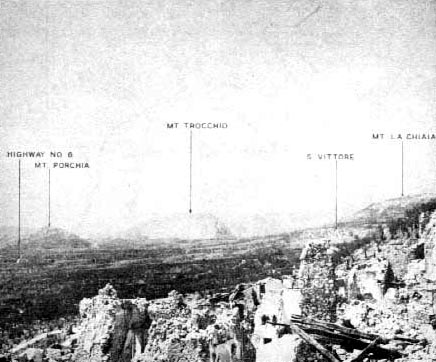
FROM THE RUINS OF SAN PIETRO could be seen the last hills
barring the way to Cassino. While troops on the right fought to
outflank San Vittore
and Mount la Chiaia, others would drive toward Mount Porchia for
a com-
bined assault on Mount Trocchio, the final position in the Rapido
Plain.
95
Porchia; meanwhile, Cedro Hill would be attacked by elements of British
10 Corps.
Artillery, air, and armored support for II Corps was available on a
large scale. The 6th Field Artillery Group of five battalions supported
the 1st Special Service Force; the 34th Division artillery and Corps units
supported the 168th Infantry; the 1st Armored Division artillery, three
tank battalions, and one tank destroyer battalion supported Task Force
A. XII Air Support Command was prepared to carry out offensive operations
whenever the weather permitted.
Capture of the Mount Majo Hills
Beyond Sammucro and the Mignano Gap, the western edge of the mountain
mass slants toward the Rapido River, with long rough slopes that reach
down nearly to Highway No. 6 (Map No. 25, below).
Possession of these slopes gave the Germans great advantage
MAP NO. 25
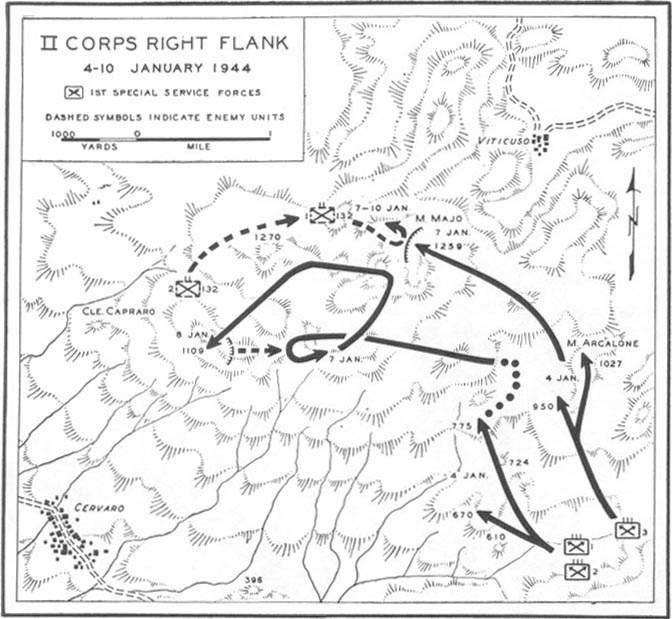
96
in defending the Rapido Valley; their positions here covered the whole
left flank and rear of the chain of outpost hills to the south. II Corps
plans therefore included an effort to drive the enemy from the mountains
flanking the axis of our advance toward Cassino. While the main battle
took place on the lower slopes, above San Vittore and toward Cervaro, the
1st Special Service Force would operate high in the mountains. In its larger
aspects, the maneuver planned for that unit was a wide end run north toward
the dominating peaks around Mount Majo (Hill 1259) and then west on the
ridges overlooking Cervaro. Success in this mission would add to the effect
of the 34th Division's attack along the lower slopes toward Cervaro. The
1st Special Service Force was trained for mountain fighting, and its abilities
would be fully tested. From footholds in the Sammucro heights it would
have to cross several miles of mountain upland, over a maze of ridges held
by the enemy. Supplies for this operation were carried by pack trains;
by 11 January these were using nearly seven hundred mules.
On the night of 3/4 January the three regiments of the 1st Special Service
Force had moved from their bivouac area near Ceppagna to assembly areas
some three miles northwest in the mountains. Patrols of the 157th Infantry,
45th Division, in the zone which was being taken over by the French Expeditionary
Corps, protected the right flank and made limited attacks to keep the enemy
occupied. At 2120 that night, the 1st and 2d Regiments of the 1st Special
Service Force pushed forward to capture the ridge running north from Hill
610 (Map No. 25, page 96). By 2000 on 4 January they had taken Hills 670,
724, and 775 against opposition consisting mainly of machine-gun and mortar
fire. On their right the 3d Regiment drove enemy outposts from Hill 950
and Mount Arcalone. The 1st Special Service Force moved with such speed
that the artillery forward observers, packing heavy radios through snow-covered
gullies and up rocky slopes, had difficulty keeping pace. Activity on 5
January was limited to patrols on Mount Majo; these were met by mortar
fire. Company E of the 142d Infantry moved up during the night of 5/6 January
to the ground gained by the 1st and 2d Regiments.
On 6 January the 100th Battalion and the 3d Battalion of the 133d Infantry,
34th Division, were placed under Col. Frederick, commanding the 1st Special
Service Force; and on the 7th the 36th Divi-
97
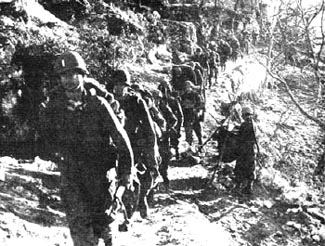
THE 1st SPECIAL SERVICE FORCE moves swiftly through the mountains
west of Mount Majo. Lt. David Cuddy leads elements of the 3d Regiment.
sion Artillery was added to his command. These units combined with the
1st Special Service Force to form Task Force B, whose specific mission
was to continue the flanking maneuver, establish a base near Hill 1109
to further the attack against Mount Trocchio, and protect the right flank
of II Corps. The 142d Infantry, which had been posted on Sammucro, was
detached from II Corps and returned to the 36th Division in reserve.
Task Force B made its next move on the night of 6/7 January, starting
from the positions won on Mount Arcalone. On the right, the 3d Regiment
of the Special Service Force, followed by Company I of the 133d Infantry,
struck over snow-covered terrain for Mount Majo and by 0520 had gained
the peak. The enemy reacted strongly; a counterattack at 0800 by the 1st
Battalion, 132d Grenadiers, was broken up. In the German attempt to recover
the mountain, reserves were rushed up and for the next three days hurled
at Majo in
98
attack after attack. These afforded the 93d Armored Field Artillery
Battalion some of the best shooting in their experience. Firing nearly
8,500 rounds from 7 to 10 January, they inflicted heavy casualties on the
132d Grenadiers.
South of the Majo peak, the 1st Regiment aimed attack across flanking ridges
toward Hill 1109, a prominent spur of the Majo mountains directly overlooking
the village of Cervaro. By 0415 on 7 January our troops were on the slopes approaching
Hill 1109, but counterattacks from three directions forced them to withdraw
to the ridge just east of their objective. That night the 1st Regiment carried
out a wide flanking maneuver to hit Hill 1109. Circling north to Mount Majo,
now in our hands, the 1st Regiment attacked west on the spur of Hill 1270. From
this higher ground they took Hill 1109 against little resistance; the enemy
had pulled out the 2d Battalion of the 132d Grenadiers to reinforce the 1st
which was making no headway in the counterattacks against Mount Majo. The initial

RIDGES RISE STEEPLY TOWARD MOUNT MAJO, which the 1st Spec-
ial Service Force captured after a swift thrust along the enemy-held
ridges
between Mount Sammucro and Mount Majo.
99
MAP NO. 26

objectives had been taken, and the 1st Special Service Force drew back
fox a night's rest, while the 3d Battalion, 133d Infantry, occupied the
captured heights.
The 168th Outflanks Mount la Chiaia
While Task Force B was winning the heights, the 168th Infantry had the
task of driving the Germans from the middle and lower slopes of the mountains
flanking the Rapido Valley (Map No. 24,
page 92). It was a difficult assignment, for small creeks had carved the
mountainsides into a series of ridges separated by narrow gullied valleys
and lying at right angles to the axis of advance. One of these ridges,
marked by several prominent knobs, extended almost to
100
Mount la Chiaia; possession of the ridge would threaten the enemy defenses
on that hill from flank and rear. Hill 396, marking the end of the ridge,
was the first main objective of the 168th in an attack coordinated with
the attack of the 135th Infantry against Mount la Chiaia itself.
The assembly area for the attack was near Hill 687, a western spur of
Sammucro (Map No. 26, page 100). Between there
and the ridge to be conquered lay the difficult valley made by San Vittore
Creek and its forking tributaries. The main creek ran in a gorge thirty
to forty feet deep, with almost vertical sides. Patrols had reported no
contact with enemy troops in this area, and the creek was set as the line
of departure. The 3d Battalion, 168th Infantry, was to make the main effort.
At 1820 on 4 January, Company I started toward the ravine to secure the
line of departure and ran into an ambush. Enemy forces at the gorge allowed
part of Company I to get through, then closed in, capturing two officers
and sixty-seven men. Preparations for the attack were nevertheless carried
through, including demonstrations further up San Vittore Creek in an attempt
to deceive the enemy concerning the direction of the effort.
At 0550 on 5 January, Company I and Company K jumped off behind a rolling
barrage fired by the 185th Field Artillery Battalion. They were pinned
at the creek line by fire from a stone farmhouse bristling with machine
guns. The situation improved during the afternoon when Company L and Company
C, on the right flank, crossed the creek farther up in the mountains and
reached Hill 425. This spur dominated the lower reaches of the creek and
capture of it freed Companies I and K. The 3d Battalion was then able to
secure the gorge. Pressing the advantage gained on the higher ground, the
1st Battalion moved beyond Hill 425 and threatened the northern end of
the key ridge which was the 168th's objective.
The morning of 6 January saw no progress. Attacking at 0900 after a
rolling barrage laid by the 175th and 185th Field Artillery Battalions,
the 3d Battalion made little headway against well-directed machine-gun
and mortar fire. On the higher flank, the 1st Battalion tried for hills
456 and 511, knobs on the 396 ridge, and was stopped five hundred yards
short. The 3d Battalion, 132d Grenadiers, was holding grimly all the way
along the ridge to the area where it merged into the mountain upland near
Hill 820.
That night a renewed attack broke the enemy defenses at the
101
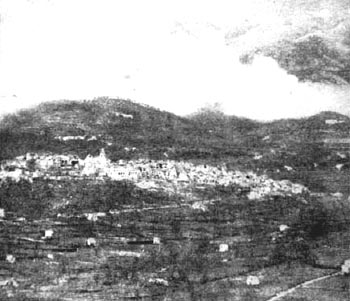
SMOKE LAID BY A-36'S on the ridge above San Vittore on 6 January
screens the 135th Infantry's attack on the village from enemy artillery
observers.
lower end of the ridge. During the afternoon the 2d Battalion moved
up to the gorge and passed through the 3d Battalion. At 2230, Company E
spearheaded the effort under orders to capture Hill 396 at all costs. In
the bitter, close-in fighting with grenades and small arms, thirteen riflemen
of Company E were killed; thirty-three dead Germans were later counted
on the hill. The enemy fell back before daylight, only to bring down heavy
mortar and artillery fire on the knob. The 2d Battalion had consolidated
its position well, and three furious counterattacks before 0600 were unsuccessful.
Many men of the 2d Battalion had distinguished themselves in the fighting
for Hill 396. Sgt. Rafael T. Hernandez of Company E disposed his squad
to counter a flanking movement, then alone went forward and
102
destroyed a machine gun and its crew. 1st Sgt. John A. Hayes, Jr., going
forward on Company G's right, corrected the fire of his platoon so accurately
that a counterattack was broken up. During the last enemy attempt to recapture
Hill 396, S/Sgt. Fred Trotter's platoon of Company E ran short of ammunition.
Trotter left his trench and recovered ten bandoleers from the battlefield.
Shot in the leg, he crawled thirty yards back to the trench. Sgt. Trotter
was killed by machine-gun fire when he raised himself to throw the ammunition
to his men, but with the recovered ammunition his platoon helped break
up the final counterattack.
During 7 January, the 168th extended its hold on the ridge above Hill
396. In stopping the 1st Battalion's attack against the higher knobs, the
enemy had profited by excellent observation from Hill 820, overlooking
the valley across which our troops had to advance. The 1st Battalion postponed
further efforts at the ridge while Company C assaulted this flanking height.
One platoon was on Hill 820 by noon, and at 1815 the position was secure.
This success settled the issue of the fight for the ridge below; the enemy
withdrew that night from the knob at Hill 456. The next morning the knob
at 511 was occupied without difficulty, and patrols reported the ground
to the west clear of enemy as far as Il Gallo Hill.
The 168th had done more than take just another ridge. Its victory at
Hill 396 contributed to unhinging the whole enemy defensive system at the
junction of his positions in the mountains with those barring the plain.
On 7 January Mount la Chiaia fell to the 135th Infantry, marking the complete
success of the 36th Division's coordinated attack.
San Vittore and Mount la Chiaia
The village of San Vittore, with its closely packed stone houses and
narrow streets, had been converted into a main enemy strongpoint, lying
near the base of Mount la Chiaia and guarding the approaches against a
frontal attack. The 135th Infantry planned to use the 3d Battalion against
this position while the 1st Battalion, crossing San Vittore Creek further
north, assaulted the northeast shoulder of the hill itself.
Once again a village stronghold had to be taken. The 3d Battalion planned
a night assault by Company K, starting at 2330 on 4
103
January, without the customary artillery preparation. Two platoons of
Company K led off. The 2d Platoon attempted to come in from the south but,
after making slight progress, was stopped by machinegun fire. The 1st Platoon,
attacking from the northeast, captured several houses before dawn, then
spent the day in house-to-house fighting with hand grenades. Snipers fired
on our troops from the stone houses; some buildings were booby-trapped.
By nightfall of 5 January one-half the town had been captured. Capt. Emil
Skalicky then sent the 3d Platoon of Company K to aid the assault on the
north while Company I attacked from the southwest. Another day was required
to clean out the enemy. By 1700 on 6 January the last of the bitter street
fighting had ended, and 170 prisoners from the 44th Grenadier Division
had been captured. Our own casualties were very light for such an operation.
The 1st Battalion met with equally stiff resistance in its attack on
the hill behind San Vittore. During the night of 4/5 January it moved to
the gulch of San Vittore Creek north of the village. Seven hundred yards
further up the creek, the 3d Battalion of the 168th was waiting for the
jump-off toward Hill 396. At 0630 the 125th Field Artillery Battalion opened
a rolling barrage, firing 1,634 rounds in ninety minutes. Despite this
support the 1st Battalion was stopped on the line of departure by enemy
fire from well-protected positions in ravines and rock pillboxes. Machine
guns were causing trouble from emplacements in -the stone houses of the
hamlet of Santa Giusta; the 1st Battalion withdrew to allow for finer adjustment
of artillery fire on these positions. On 6 January the battalion tried
and failed again to cross the creek line. The 2d Battalion, which had been
in reserve, took over the attack and succeeded in making a rapid thrust
across the face of the hill. On 7 January, with San Vittore and Hill 396
lost, enemy resistance faded and Mount la Chiaia was occupied by the 135th.
The 3d Battalion moved promptly west from San Vittore and drove the enemy
from Hill 224 and Cicerelli Hill, low knobs between Mount la Chiaia and
Highway No. 6. A German troop concentration west of Mount la Chiaia was
dispersed at noon by sixteen A-36's and an equal number of P-40's. As a
result of the combined efforts of the air force and the infantry, the remnants
of the 134th Grenadiers withdrew westward in confusion. Bypassed enemy
groups were mopped up and minefields cleared, especially from the San Vittore
area. On the trail from Santa Giusta
104
MAP NO. 27
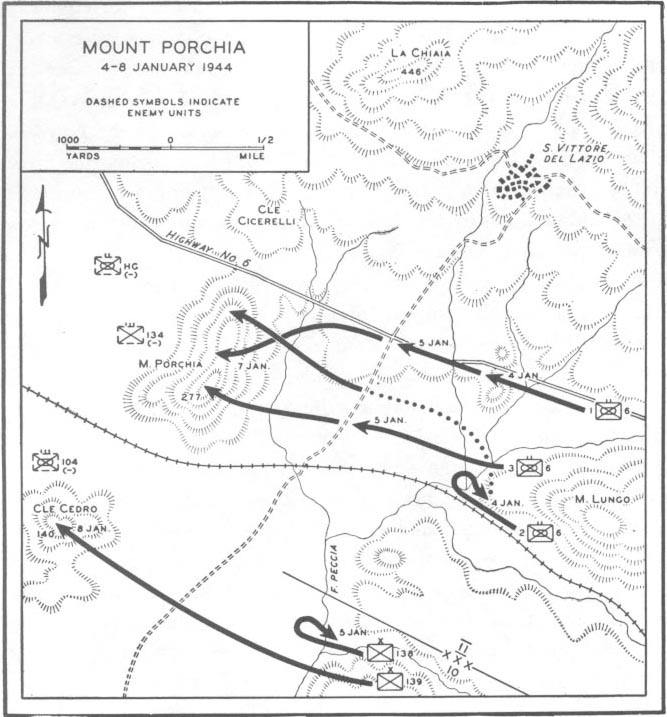
our men encountered a new type of German weapon, a concrete mine with
plastic fuse, which could not be located by detectors.
Mount Porchia and Cedro Hill
On the left wing, II Corps' offensive involved taking Mount Porchia,
just south of Highway No. 6 (Map No. 27, page
105). Task Force A was given the assignment of attacking this isolated
hill. One mile southwest, the smaller companion height, Cedro Hill, lay
in 10 Corps' zone and would be difficult for the enemy to hold after the
fall of Mount Porchia.
The 1st Battalion, 6th Armored Infantry, moved on the afternoon of 4
January to secure its line of departure. The battalion encoun-
105
tered difficulty in clearing two small rises on either side of Highway
No. 6, just north of the end of Mount Lungo, which were vigorously defended
by the 5th Company, 134th Grenadiers. Losing his positions by 1930, the
enemy counterattacked. Heavy mortar fire met the 2d Battalion as it tried
to move west astride the railroad. Until noon of 5 January, the Germans
fought hard to stop the drive short of their main defenses. Mauled severely
by fire of our artillery, tanks, and tank destroyers, they were forced
to withdraw toward prepared positions on Mount Porchia.
At 1515, after an artillery preparation of thirty minutes, the 3d Battalion
of the 6th Armored Infantry led an attack that reached the north-south
road in front of Mount Porchia. At dawn of 6 January the 1st and 3d Battalions
were ready to resume the effort toward their objective; the 2d Battalion
came into the center of the line to join the assault, which began at 0700.
Little progress was made during the morning, though tanks attached to Task
Force A finally reduced the machine-gun nests in stone houses and pill
boxes. Early in the afternoon, after another artillery preparation which
included smoke to cover the north flank of the zone, parts of Companies
A and B reached the crest on the north end of Mount Porchia. The combat
strength of the 1st Battalion had been reduced to 150 men. At 1800 the
48th Engineer Combat Battalion (attached to Task Force A) was committed
to the attack as infantry, with companies attached to each of the battalions
of the 6th Armored Infantry. An enemy counterattack was launched at 2210
from the northwest by three infantry companies of the Hermann Goering Panzer
Division which had been rushed from reserve positions, six miles west of
Cassino, to help defend Mount Porchia. The Germans reached positions behind
American units on Porchia and caused considerable confusion, but the reinforced
6th Armored Infantry held its gains.
Despite the enemy efforts, the entire hill fell on 7 January. During
the morning the Germans continued to resist from positions near the summit
and the southwest edge, but all three battalions of the 6th Armored Infantry
succeeded in fighting their way to the crest all along the hill by noon.
At 1500 the enemy counterattacked and was beaten off; strong artillery
support helped the 6th Armored Infantry hold Mount Porchia. After one more
effort to take the hill that night the Germans withdrew.
106
South of this battle, the 46 Division of the British 10 Corps had been fighting
for Cedro Hill against the same type of enemy resistance. During the night of
4/5 January the 138 Brigade established a bridgehead across the Peccia River
against strong opposition by the 104th Panzer Grenadier Regiment; but, with
Mount Porchia still uncaptured and their supporting tanks unable to cross the
river, the British troops fell back to the east bank at dusk. The 139 Brigade
took over the assault and reached Cedro Hill by daylight on 8 January, but enemy
mortar fire pushed it back. After the fall of Mount Porchia, the Germans evidently
judged their positions on Cedro untenable; that night they abandoned this last
of their outpost hills in front of Mount Trocchio.
MAP NO. 28

107
The Final Advance: Cervaro and Mount Trocchio
By 8 January, the Germans had lost their best positions for defending
the approaches to the Liri Valley and their Gustav Line. The la Chiaia-Porchia-Cedro
hill barrier had fallen; further north, II Corps had secured the higher
mountain ground above Cervaro. Nevertheless, possibilities for a last line
of forward defense were offered by Mount Trocchio and the rough hills at
the edge of the mountains near Cervaro. There was every indication that
the enemy would continue his stubborn delaying tactics and that II Corps
would have to fight all the way to the Rapido River.
Attack orders for the final drive were issued by II Corps on 9 January,
with Mount Trocchio as the main objective and the 34th Division still carrying
the main weight of the assault (Map No. 28, page
107). That division planned to strike first at the Cervaro area, clear
the enemy from his last foothold on the adjacent mountain slopes, and thus
uncover the north flank of Trocchio. The 168th Infantry would attack toward
Cervaro from the ridges to the cast. From its vantage ground higher in
the mountain, Task Force B would continue westward and clear out the last
mountain spurs north of the village. On the left flank, the 135th Infantry
was to threaten Cervaro from the south, by an advance from la Chiaia.
Due to start on 10 January, this coordinated attack required three days
to carry through against obstinate resistance.
The 168th planned to use two battalions, the 2d attacking from the Il
Gallo spur (Hill 497), the 1st from the next small ridge to the northwest,
Hill 552. The 1st Battalion had to fight a sharp engagement to secure its
jump-off position. On 9 January, Hill 552 having been reported clear of
enemy, Company C started down to occupy it from Hill 820. The Germans had
returned to 552, and Company C was forced to make a night assault. Two
platoons attacked the spur from the south, another platoon came in from
the east across a deep gorge, and the Cannon Company of the 168th gave
decisive fire support from the right flank. 1st Lt. James G. Nielson, commanding
Company C, had reconnoitered the German positions and was able to direct
fire that ranged in fifty yards to the right of the attacking troops and
completely neutralized the enemy's fortifications. The assault carried
through, taking thirty prisoners and killing twenty Germans. By dawn Company
C had Hill 552,
108
but further difficulties arose to delay the 1st Battalion's attack,
scheduled for noon. Enemy fire opened unexpectedly from the right flank;
higher up the mountainside, some bypassed German positions on Hills 661
and 860 were in a good situation to command the approaches to 552 from
the east. It took Company A most of the day to mop up these small nests,
killing twenty Germans in the process. This nuisance resistance on its
flank prevented the 1st Battalion from moving past Hill 552 toward Cervaro
in support of the 2d Battalion of the 168th. Attacking alone, in columns
of companies, the 2d Battalion got to within a half mile of Cervaro and
dug in for the night.
By morning of 11 January the 168th Infantry was in position for direct
assault on Cervaro. Like San Pietro and San Vittore, this little mountain
town had been reduced to a mass of rubble and shattered walls, but the
wrecked stone houses and cellars gave excellent protection for the enemy,
who had organized firing positions to cover all the approaches. The 2d
Battalion, 71st Panzer Grenadier Regiment, held this sector, reinforced
on the night of 10/11 January by elements of the Hermann Goering Panzer
Division.
Before the attack of 11 January our planes bombed and strafed Cervaro,
after which artillery took over and covered the area with a heavy barrage.
At 1230 the 3d Battalion, 168th Infantry, started a push west from 552
to seize the ridges a half mile north of Cervaro, thus covering the right
flank of the main effort and threatening the enemy's rear. Elements of
the 1st Battalion were moving west from Hill 552, following the advance
of the 3d. When the 2d Battalion jumped off at 1300, driving straight for
the town, Mount Trocchio, had been smoked and tanks were in position to
give supporting fire from south of the town. The battalion attacked in
column of companies under continuous artillery, mortar, and small-arms
fire. They reached the corner of Cervaro at dark, while the 3d Battalion
gained the slopes overlooking Cervaro from the north as far as Hill 302.
During that night the 2d Battalion worked around the northern edges of
the village and by dawn was on a small hill at the northwest corner. The
Air Observation Post in communication with the 175th and 185th Field Artillery
Battalions directed effective fire on enemy troops and vehicles in Cervaro.
At 1100 the 2d Battalion launched a final assault from the north and captured
the village after two hours' fighting in the ruins. On the northern flank,
the 3d Battalion met opposition when it tried to advance further
109
west, but reached Hill 210 at the end of the afternoon of 12 January.
Cervaro had been taken, but there was no collapse of enemy resistance.
Whether to cover a withdrawal or to attempt a counterattack, elements of
the 1st Battalion, 2d Hermann Goering Panzer Grenadier Regiment, came up
that night on the road from Cassino, only to stumble into a costly meeting
engagement with the 2d and 3d Battalions a few hundred yards west of Cervaro.
A battalion volley of artillery fire on the gorge near Le Pastinelle helped
to stop the enemy. The next morning, 13 January, the 168th reached the
slopes overlooking Le Pastinelle and the Rapido plain. The regiment was
only a mile from Mount Trocchio and in position to threaten it from the
northeast.
The 168th Infantry had been helped in its success at Cervaro by supporting
attacks both to the north and south. Task Force B had kept pace in the
mountain area, attacking west from Hill 1109 and covering the 168th's right
flank. In two days' fighting the 100th Battalion and the 1st Battalion
of the 133d Infantry gained Mount Capraro on 12 January and began to push
the Germans down the last mountain slopes north of the Cassino-Cervaro,
road. When Task Force B was broken up on 13 January, its mission completed,
the 133d Regimental Combat Team stayed in line on the right flank of the
advance threatening Mount Trocchio.
South of Cervaro, the 135th had been aiding the 168th's fight by making
a limited attack from Mount la Chiaia toward Le Pastinelle, thus threatening
an encirclement of the Cervaro strongpoint. The 2d Battalion of the 135th,
making this effort, found a center of enemy resistance at Point 189, where
a company of the 2d Hermann Goering Regiment had converted some stone houses
into pillboxes. Although Company G of the 135th captured a part of the
position on 10 January, the enemy held on tenaciously for three days, preventing
a penetration behind his defenses at Cervaro. Finally, on 13 January when
the 168th was advancing north and west of Cervaro, the 2d Battalion of
the 135th carried the 189 strongpoint.
Always, in fighting out from the Mignano Gap toward Cassino
110
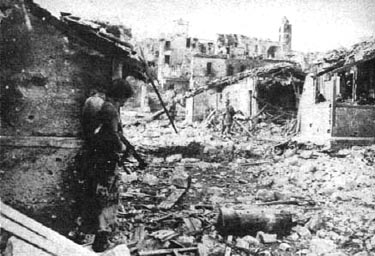
A PATROL ENTERS CERVARO on 12 January. Sgt. Charles Russell covers
Sgt. Barney Wright as they search for snipers. Two men of this patrol
were
killed by snipers a few minutes later (top).
THE GROUND WON BY II CORPS in the Winter Line
Drive. Picture
(bottom) was taken from above Cassino after the fall of the city.

111
and the Liri Valley, II Corps had seen Mount Trocchio looming ahead
of them as the last and most formidable obstacle. Now, by 14 January, our
troops had driven the Germans from all their intermediate defenses and
were facing Trocchio itself, main objective of the attack that began on
10 January. To capture the enemy's last stronghold in front of the Rapido
River, II Corps prepared a blow in great force for 15 January. The 34th
Division would direct its main effort against the northern flank of Trocchio,
with the 168th Infantry striking through Le Pastinelle on the axis of the
Cervaro-Cassino road. Two battalions of the 135th Infantry had Mount Trocchio
itself as their assignment. On the left flank, two battalions of the 141st
Infantry, 36th Division, which had relieved the 6th Armored Infantry, would
take the southwest corner of the hill.
But the enemy for once was ready to yield ground without a fight. Evidently
considering Mount Trocchio a hopeless position when its north flank was
uncovered, he had withdrawn his main forces across the Rapido. II Corps'
attack on 15 January encountered no resistance other than harassing artillery
fire; three hours after the start, advance elements were neutralizing booby
traps on the crest of Trocchio.
North of II Corps, the French Expeditionary Corps had been equally successful
in the mountains, carrying through the work begun by VI Corps. The high
peaks had been taken as far north as Mount Acquafondata, and the French
advance carried on 16 January to Sant' Elia.
112
page created 20 July 2001
Return to the Table of
Contents
Return to CMH
Online









